you are here [x]: Scarlet Star Studios > the Scarlet Letters > speaking @ the "world puppet animation" show
<< before
demo wire armature
after >>
open studio second anniversary & edible book tea
March 12, 2007
speaking @ the "world puppet animation" show
by sven at 3:30 pm
Yesterday I had my speaking engagement at the "World Puppet Animation" show. Thanks gl. for taking photos!
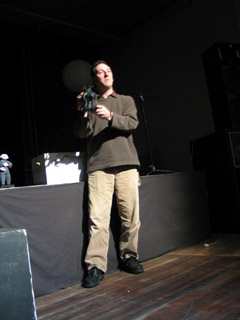
I felt it went pretty well. When I spoke, I felt like I knew just what I wanted to say -- and I didn't "um" much. After the films were over, the audience wanted to hear about my reactions to what we'd seen... I wasn't as sure-footed for that part, but see now how I could be better prepared to respond in the future.
There were 9 or 10 of us at the show. I suspect it being a Sunday -- and the Daylight Savings change -- probably kept numbers low.
There was a version of Puss and Boots by the Diehl brothers from Nazi-era Germany that was astonishing; the puppets and sets all looked like they were made by master doll-makers.
We saw a George Pal short -- featuring his unique replacement animation technique -- which I'd seen previously in The Puppetoon Movie. [If you're into stopmo, you must see this film!]
There was a Rankin & Bass-style film from Czechoslovakia titled "The Problem" which I absolutely adored -- and which I will probably never have the opportunity to see again. I'm very glad I went to this show -- even if I hadn't been speaking!
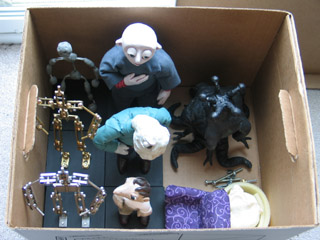
I didn't have any written notes for the speaking... But I did have a mental outline. Here's what I said, as best as I can reconstruct it.
[I. INTRODUCE MYSELF]
My name is Sven Bonnichsen. I'm a mixed media animator. That means I do two-dimensional drawn animation, computer animation, and stop-motion puppet animation. My focus is on puppet animation, and I specialize in making metal armatures -- the skeletons that go inside of puppets so they can hold a pose.
[II. DIFFERENCES BETWEEN TYPES OF ANIMATION]
I want to start by saying a little about the differences between puppet animation, drawn animation, and computer animation.
When you're doing drawn animation, you start by making your "keyframes" -- the most important poses in a sequence. Then, you draw the "in-betweens" that get you from point A to point B. This is all on paper -- so as you work, you can flip through the pages to check that your animation is going how you want it to.
Not so with puppet animation. With puppet animation, you start with frame one, and just have to keep going forward. Once you start work on a sequence, you have to keep direction of momentum and arcs of motion all in your head -- so it's very important that you do NOT stop in the middle!
Computer animation, like drawn animation, makes use of in-betweens. You define point A and point B, and then let the computer figure out how to move your model from one point to the other.
Computer animation is very popular with big movie studios because you can have a whole team of animators working on one sequence. One person can be working on the motion of the arm, while another is working on the eyes -- and you can go back and edit what you've programmed endlessly.
Not so with puppet animation. With puppet animation, it's much more like a performance -- and the animator is like an actor. It's just one person going "mano a mano" with the puppet, getting into the puppet's head, breathing life into it.
One thing that I really appreciate about puppet animation, personally, is this tactile experience of being able to manipulate the puppet with your own hands.
Right now I'm working on a film titled "Let Sleeping Gods Lie" -- which, if all goes well, will appear in the H.P. Lovecraft Filmfest this October. In it, I've got these creatures with five legs. I'm trying to figure out how on earth a thing with five legs is supposed to walk...
In the film I've got both a CG model of the critter and a puppet version. When I'm working with the CG version, with the computer screen between me and it, I can't figure out for the life of me how it's supposed to move. But when I work with the puppet model, holding it in my hands I can begin to get a sense of things. "OK, as it leans this way, the weight of the thing has to transfer from this tentacle to this one..."
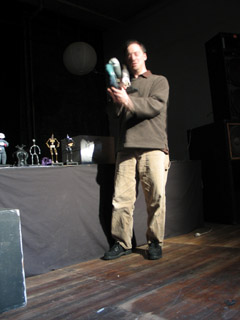
[III. PUPPET ANATOMY]
OK, so that's a little about the differences between different types of animation. Now I'd like to tell you a bit about the anatomy of a puppet, so you can better appreciate what you're going to be seeing tonight.
[III-A. TIE-DOWNS]
The most important thing to know about a puppet is that it has to be able to remain absolutely still between frames. When you're animating, you create the illusion of life by very carefully moving the puppet a little bit at a time. If the puppet twitches uncontrollably each time you snap a frame, then the illusion is destroyed.
So, one of the first things I always check on a puppet is if it can do an extreme lean. [I demonstrate Percy leaning forward.] Think about it: If you're taking a step, there's that moment before your foot touches down when you're leaning far forward... Can the puppet hold that pose without tipping over?
In order to keep the feet planted where they belong, you use "tie-downs." You drill holes in the floor of your set, and then these screws [I demonstrate] come up from underneath, and screw into little nuts in the feet of the puppet.
[III-B. ARMATURES]
In order to hold poses, the puppet needs to have a good armature inside of it.
There are three main types of armatures: ones that are made out of wood, or wire, or metal ball-and-socket joints.
Wood armatures were used a lot in early Eastern European puppetfilms -- but they're not used very much anymore, because the joints tend to wear down and lose their tension.
Wire armatures are the easiest type to make -- and are still used quite a bit in professional productions.
Metal ball-and-socket armatures are in many ways the best sort of armature, and get used extensively in feature-length projects.
Differences between wire armatures and ball-and-socket ones:
With wire armatures, you always have to be aware that the wire is ultimately going to break.
There are things that you can do make it less of a catastrophe when the armature does break. You can make your puppet with a detachable head and hands. That way when the wire breaks, the parts that you put the most work into -- which get the focus on screen -- can still be salvaged. [I demonstrate detaching Percy's hand.]
On a person, the elbow bends at one point. With a ball-and-socket armature, you can also have the elbow bend on a point -- which is nice. On a wire armature, though, if you bend the wire repeatedly on one point, it's going to break a lot quicker. So what you want to do is have slack at the elbow, so the wire bows gently, and the stress on the wire gets distributed.
Generally speaking, a ball-and-socket armature isn't going to break. But sometimes the joints do get loose -- and you're going to have to get inside the puppet to tighten them.
A ball-and-socket armature is sturdier and more precise than a wire armature. (With a wire armature, the wire springs back a little when you pose it.) But ball-and-socket armatures are also generally bigger -- and they're more expensive and labor-intensive to create.
So there are pros and cons to both.
[III-C. PUPPET COVERINGS]
Now, once you have your puppet armature, what are you going to cover it with?
There are three main options...
You could cover the armature with Plasticine and do claymation with it.
(A lot of people use the word "claymation" to mean anything that's stop-motion. "Claymation" is actually a trademarked term, coined by Will Vinton -- most famous for the California Raisins -- whose studio used to be right here in Portland. However, the word has gone into common usage... Sort of like how "Kleenex," which is a specific brand, has become synonymous with "facial tissue.")
For a very detailed puppet, you could cast the armature inside of a flexible material, such as foam latex -- which you might find in the soles of your shoes -- or silicone. The puppets in "The Corpse Bride" were made from silicone, which was a tremendous technical breakthrough.
Or, a third option, you could wrap the armature in strips of cushion foam [I demonstrate] -- like the foam you'd find in your couch -- and make the head and hands out of something hard, like Super Sculpey or Epoxy clay. Then, the body, you'd probably cover in fabric to make clothes -- or perhaps in fur, if it's an animal. This is more or less the process that was used to make the original King Kong puppet in 1933.
So: That's generally how to build a puppet for puppet animation.
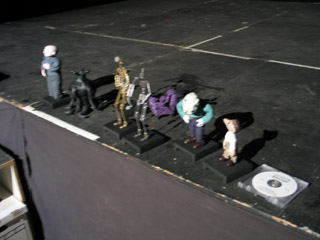
[IV. THE STOPMO COMMUNITY TODAY]
I want to wrap-up by saying that we are living in very exciting times, in terms of stop-motion animation.
When you're learning how to do puppet animation, there's an incredible learning curve. You need to figure out how to make armatures, and do puppet fabrication, and make clothes, and build sets and props, and rig lights, and work the camera...
Up until about ten years ago, you really had to hunt and search to find information about how to do this stuff. But now, an amazing online community of animators has been forming, sharing knowledge -- making it easier to learn the art than it ever has been before.
(And, with digital cameras and laptop computers now -- just about anybody who wants to could get into this art!)
The main hub for information -- globally -- is StopMotionAnimation.com. It has a sister website, StopMoShorts.com, which has a quarterly challenge, to encourage people to make puppetfilms.
[V. CLOSING - FREEBIES]
I just want to show you now my puppets "Dad" and "Jimmy," who starred in a film that I made this last year for StopMoShorts.com. Dad is a sort of gruff, authoritarian father; and Jimmy is his mischievous son, who doesn't want to do his chores.
I've brought along copies of the film, "The Great Escape," as freebies. Who here would like one? (Pass them back, please...)
OK, that's it. Thank you very much to Dennis Nyman. Are there any questions that anyone would like to ask at this point?
...
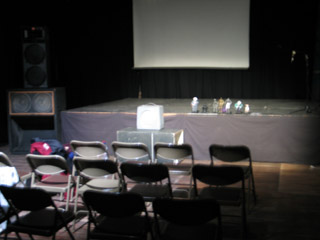
posted by sven | March 12, 2007 3:30 PM | categories: exhibits & events, stopmo